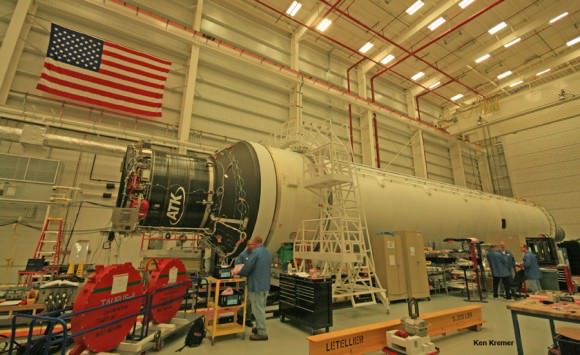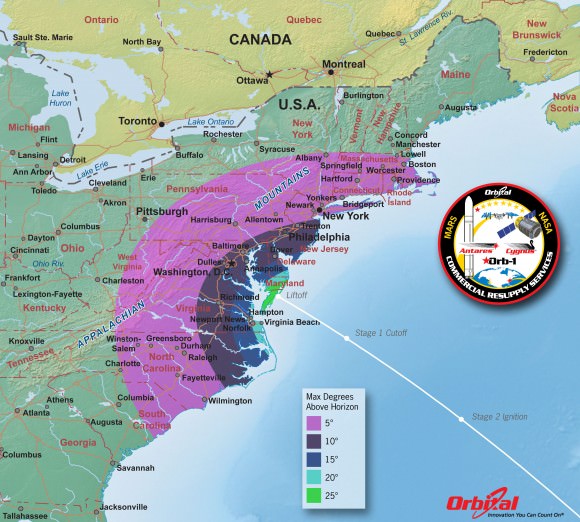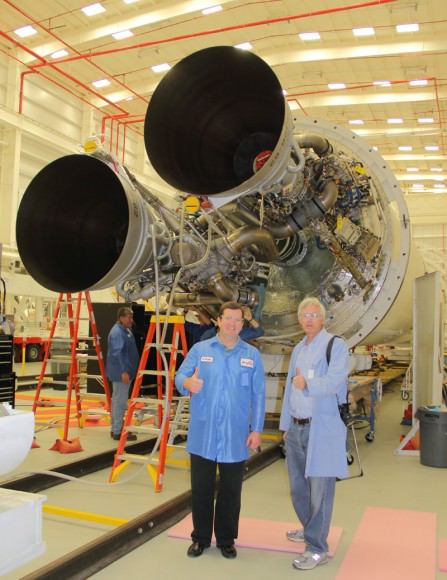Seaside panoramic view of an Antares rocket and Cygnus cargo spacecraft built by Orbital Sciences at Launch Pad 0A at NASA Wallops Flight Facility on the Virginia Eastern Shore. Blastoff for the ISS is slated for Jan. 7, 2014 at 1:55 p.m. EDT. Credit: Ken Kremer – kenkremer.com
UPDATE – Frigid Weather Delays Antares Launch to Jan. 8[/caption]
The status quo in space flight operations is no more.
Private American rockets are leading the charge of overdue change into the innovative ‘Commercial Space Race’ by blasting 2014 open with a pair of ‘Big Bang fireworks’ just a day apart on Jan. 6 and Jan. 7.
A dynamic duo of US aerospace firms – SpaceX and Orbital Sciences – are each poised to launch their own recently developed private boosters in the first week of the new year and aiming to dramatically cut costs.
And to top that off, the rockets are thundering aloft from two different spaceports located some 800 miles apart along the US East coast – weather permitting of course given the monster snow storm and frigid arctic air – akin to Mars – bearing down at this very moment on the big populations centers of the Atlantic coast region.
UPDATE ALERT – Antares Launch just postponed to Wed, Jan 8 at 1:32 p.m.due to extremely cold weather forecast. Back up day is Jan. 9
Both companies are revolutionizing access to space for both government entities as well as commercial companies doing lucrative business in space.
The implications of vastly reducing expenses for space travel and space commerce are far reaching and imperative – especially in the face of static and declining budgets mandated by politicians worldwide.
Except for China, which just landed its first rover on the Moon, is investing mightily in space and science and reaping strong economic growth.

SpaceX is first on deck with their next generation Falcon 9 rocket poised to soar on Monday, Jan. 6, with a highly valuable international payload – the Thiacom-6 commercial broadcasting satellite.
Note: This launch has just been postponed from Jan. 3 according to a brief statement I received from the USAF 45th Space Wing. Apparently due to concerns with the rocket – better safe than sorry.
Orbital Sciences follows up quickly on Tuesday, Jan. 7, with their two stage Antares rocket carrying the firm’s own Cygnus cargo vessel on its first operational commercial resupply mission for NASA – that’s bound for the International Space Station (ISS).
The upgraded SpaceX Falcon 9 v1.1 two stage rocket is slated to launch from complex 40 at Cape Canaveral Air Force Station, Florida, likely at dusk.
The original Jan. 3 Falcon 9 evening time launch had been scheduled for 5:50 p.m. Thaicom-6 will be placed into an elliptical supersynchronous transfer orbit.
The commercial space race sometimes makes for strange bedfellows. The Thaicom-6 satellite was built by Orbital Sciences.
This marks only the 2nd launch of the newly upgraded Falcon 9 from Florida. Read my eyewitness reports about the thunderous maiden liftoff barely a month ago on Dec. 3, 2013 with the SES-8 commercial telecom satellite – starting here.
The new Falcon 9 is the key to achieving SpaceX’s future launch manifest of some 50 payloads worth billions of dollars.
The next gen Falcon 9 will also launch the human rated SpaceX Dragon to the ISS. But first the Dragon and Falcon 9 must successfully achieve a pair of abort tests planned for 2014. Read my new article and discussion with SpaceX CEO Elon Musk – here.
The Jan. 7 Antares liftoff is currently scheduled for 1:55 p.m. EST from Launch Pad 0A at the Mid-Atlantic Regional Spaceport (MARS) at NASA Wallops Island, Virginia.

The Antares launch comes on the heels of the completely successful demonstration flight to the space station by Orbital Sciences in September 2013.
This flight was originally scheduled for mid-December 2013 in prime time but was postponed due to the urgent repairs required to get the ISS cooling system back in full operation.
And although it’s now moved to daylight by reason of orbital mechanics, the liftoff could still easily be visible to millions of residents along a wide swath of the US East Coast spanning from North Carolina to New York City – weather permitting.

The Antares daytime launch will be visible to millions of spectators across a wide area of the Eastern US -weather permitting. This map shows the maximum elevation (degrees above the horizon) that the Antares rocket will reach during the Jan 7, 2014 launch depending on your location along the US east coast. Credit: Orbital Sciences
I’ll be covering the Antares launch, dubbed Orb-1, from on site at NASA Wallops – watch for my continuing reports.
The Cygnus logistics vessel will carry a total of 2,780 pounds of supplies to the station, including vital science experiments to expand the research capability of the Expedition 38 crew members aboard the orbiting laboratory, crew provisions, spare parts and experiment hardware, says NASA.
Also packed aboard the Antares/Cygnus flight are a batch of student experiments involving life sciences topics ranging from amoeba reproduction to calcium in the bones to salamanders.
“The 23 experiments flying next week [on Antares/Cygnus] are the culmination of 8,700 students engaged in real experiment design, and 1,800 proposals received by student teams,” Dr. Jeff Goldstein told Universe Today. Goldstein is the Center Director for the National Center for Earth and Space Science Education (NCESSE),which is sponsoring and organizing the student experiments.
This rocket volley is but the opening salvo of shots heard reverberating round the world that will surely “rock” the space industry to its core by cutting the steep cost of access to space.
“This is really rocking the industry. Everybody has to look out,” said Martin Halliwell, SES chief technical officer during a recent media briefing with Elon Musk, including Universe Today.
Both the SpaceX Falcon 9/Dragon and Orbital Sciences Antares/Cygnus vehicles were developed from the start with seed money from NASA in a public-private partnership.
The goal was to restore America’s cargo and crew capabilities to low Earth orbit and the ISS that was totally lost following the forced retirement of NASA’s Space Shuttles.
After a slow start, both Orbital Sciences and SpaceX have succeeded in bringing their new rockets and delivery vehicles safely on line.
SpaceX next Dragon cargo launch to the ISS is currently scheduled for Feb. 22, said SpaceX spokeswoman Emily Shanklin to Universe Today.
Stay tuned here for Ken’s continuing SpaceX, Orbital Sciences, commercial space, Chang’e-3, LADEE, Mars and more news.
…………….
Learn more about SpaceX, Orbital Sciences Antares Jan. 8 launch, Curiosity, Orion, MAVEN, MOM, Mars rovers and more at Ken’s upcoming presentations
Jan 7-9: “Antares/Cygnus ISS Rocket Launch from Virginia on Jan. 8” & “Space mission updates”; Rodeway Inn, Chincoteague, VA, evening



I note that the Baikonur cosmodrome is at latitude 45.96° N
The Wallops Island facility is at 37.8° N.
The Kennedy Space Center/Cape Canaveral is at 28.5° N.
The Japanese Tanegashima Launch Center is at 27° N.
ESA’s site at Kourou, French Guyana site is at 5.2° N.
This means that the Ariane 5 has the biggest ‘throw weight
advantage’ due to Earth’s rotational speed.
NO wonder the Russians built a launch facility there!
(The Hawaiian Islands are at 21.13° N)
Ah yes but in a comment ruthlessly quoted from Steve Pemberton offered at another site…
To put this in perspective, if we assume launching to ISS at 17,100 mph, then the acceleration needed from each site is:
Equator 16,062 mph,
Brownsville 16,167 mph,
KSC 16,189 mph,
Wallops 16,281 mph,
Baikonur 16,374 mph.
It can be kind of a subtle difference in burn time.
In any case, really looking forward to Dr Kremer’s shots of Thaicom-6 going up.
Dusk launches are great when you capture the LV breaking into sun strong light. Very dramatic 🙂
Steve James Pemberton (born 1 September 1967) is an English actor, comedian, writer and performer, most famous as a member of The League of Gentlemen…
I find that the Earth’s rotational speed is: (from http://www.thevlecks.net/rmj/earth.html
@ 45.96° N approx. 721 mph – 17,100 mph = 16,379 mph
@ 37.8° N approx. 818 mph – 17,100 = 16,282 mph
@ 28.5° N approx. 916 mph -17,100 = 16,184 mph
@ 27° N approx. 930 mph – 17,100 = 16,170 mph
@ 5.2° N approx. 1030 mph – 17,100 = 16,070 mph
@ 0° approx. 1,037.58 mph – 17,100 = 16,063 mph required for orbital velocity. (17,100 mph being actual orbital velocity)
Subtle difference? Granted a delta V of some 309 mph between extremes shown above isn’t much (?) but consider the liftoff weight of the Antares rocket is some 530,000 pounds (240,000 kilograms), then calculate how much more thrust you need to launch and to achieve orbit from either location… which is my point.
GO Antares!
Hi Aqua,
Thanks. The point is clear enough. The particular Steve Pemberton quoted is here on the discuss network http://disqus.com/stevepem/.
FWIW: There’s a very lively discussion on the comparative benefits of Earth’s rotational speed in a NASAwatch thread Why Does Space Florida Need Its Own Spaceport?
Cheers,
TG.
There is just over 141.5 m/s of difference between launches from 0° and 45.96° N, using your numbers. That doesn’t take much to overcome, though it is probably too large to rightfully call an insignificant difference.
The big difference is probably the deltaV needed to match inclination with the station between the two extremes in latitude.
Thanks. to bad its beyond my means to cover both launches. I’ll be at Antares. hope you saw my last SpaceX dusk launch pics from spectacular Dec 3 launch with SES-8:http://www.universetoday.com/106903/spacex-scores-spectacular-success-scorching-florida-sky-with-next-gen-rocket/
Fair enough.
There will be plenty of other opportunities this year: SpaceX will fly Dragon CRS missions on Feb 22nd, also June, September and December, Orbcom in March, AsiaSats in April and May, and of course 2014 is the year of the BIG kahuna – the Falcon Heavy. 🙂
Do I expect to see virgin galactic start their space tourism business this year?
I’ve been waiting for it since when they keep pushing back dates.
Frigid weather just resulted in Launch delay to Jan 8 – back up day is Jan 9
Is that for the SpaceX or the Orbital launch?
Orbital
Not sure. Apparently they’ve been running into pretty extreme issues with the hybrid rocket motor they’re using in their suborbital rocket. It worked great as a small engine, but it didn’t scale up well to the new, larger design. Not only has it proved to be unable to muster up enough power to loft the second generation 7 seater into space (this is why they’re 4 years behind schedule and counting), it’s also had way more safety issues than they were anticipating.
I’ve read some speculation that they’ll have to replace that motor with something better before they’ll be able to launch a full passenger load, but no one is quite sure yet.
Very interesting gopher652003, do you have a link for this info.?
Does anyone have any thoughts about the visibility of tonight’s Falcon 9 launch to people in the Carolinas?